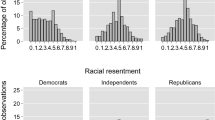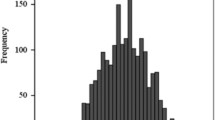Abstract
We use Google Trends data to identify hostile sexism and find that sexism negatively predicts Clinton’s vote share in the 2016 general election and is associated with lower voter turnout among those more likely to vote for a Democrat. Although we find no evidence that hostile sexism was more prevalent in states in which Trump held more than 10 pre-election rallies, we find that sexism had a larger impact on votes in these areas. This shows that the marginal effect of sexism was not uniform across the country and links the differing magnitudes of the effect to Trump rallies.


Similar content being viewed by others
Notes
A media market is a collection of counties identified by Nielsen Media Research that receive the same television broadcasting.
For example, Owen and Wei (2022) provide an analysis of Trump Tweets insulting Clinton and show that two of the most frequently lobbed insults called Clinton “crooked,” or assailed her for “bad judgement.”
These findings are consistent with Bauer (2015), who captures the idea that political rhetoric can activate gender stereotypes. Examples of rhetoric include Trump mocking Clinton for lacking “strength” and “stamina”, accusing her of “playing the woman card”, and claiming that she does not have a “presidential look” (Rappeport 2016). Owen and Wei (2022) show that Tweets by Trump that insulted women were associated with higher volume of sexist searches, aiding our interpretation that Trump activated sexism through his rhetoric.
The work of Becker (1971) provides a model, taking preferences as given, in which discrimination can be rational. However, not all discrimination is rational. In particular, discrimination is not rational if preferences and beliefs that generate hostile sexism are not rationally formed or if it is based on implicit bias of which the individuals may not be consciously aware.
We use the same method to construct the index as that described in Owen and Wei (2021), however, we use Google searches from a different time period so the resulting data is not identical. The data for this study is available at https://doi.org/10.7910/DVN/RY4K4H.
Several in the literature distinguish between different forms of sexism, identifying hostile sexism as the most relevant predictor of support for Trump in 2016 (Bock et al. 2017; Cassese and Holman, 2019). Because of these findings and the difficulty of measuring benevolent sexism using our methods, we do not pursue an effort to estimate the impact of benevolent sexism on the election. Furthermore, our measure of sexism captures hostility towards women and does not capture sexism that might generate a positive preference for female candidates. As a result, our conclusions are limited to the impact of hostile sexism.
For example, the 2016 ANES fielded only 1,840 questions answered by only 4,270 respondents.
Google provides a vast number of searches that make it easy to identify queries that pertain directly to hostile sexism (Sullivan 2016).
The first four components explain 83 percent of total variation.
A more detailed description of the construction of the index are in Owen and Wei (2021).
Top searches of a racism index from Stephens-Davidowitz (2014) are similar. They include “song”, “song lyrics”, and “jokes” which together suggest that prejudice towards women and African Americans are expressed in similar ways on the internet.
We download the media market level data with an algorithm from Stephens-Davidowitz (2014). This algorithm addresses any potential issues with Google’s normalization procedure.
See Owen and Wei (2021) for further correlations between the Sexism Index and the gender wage gap as well as sexist attitudes from survey data.
Another less probable scenario is that Green party supporters motivated by sexism switched their votes to Trump.
Trump rally dates and locations for the general election are from Appleman (2019) and we supplement the list with primary election rallies from Wikipedia. Our results are robust to using only the general election rallies documented in Appleman (2019). More generally, this indicator variable may also be a proxy for significant attention in the state by the Trump campaign. These seven states rank in the top 11 for total advertising spending by the Trump campaign (Dumenco 2016).
Demographic characteristics come from the American Community survey. They are averaged over the 2013-2016 period. Unemployment rates are obtained from the Bureau of Labor Statistics.
For media markets that encompass more than one state, we use the state where the highest number of residents live. We follow Stephens-Davidowitz (2014) and Corbi and Pichetti (2020) in using census division fixed effects instead of state fixed effects. Using state fixed effects would preclude the interpretation of the Trump Rally dummy variable and dramatically reduce our degrees of freedom.
When those are added to the specification in column 1, the adjusted R-squared jumps to 93% (Obama) or 82% (Kerry).
The VIF for the estimations reported in Table 4 ranges from 3.11 to 3.17, reducing concern that results are being driven by multicollinearity.
Arguably, Jill Stein was a Trump opponent, however, he did not directly target her in his campaign.
An area’s racially charged search volume is defined as the 2004-2015 search volume of n-word(s), normalized by Z-score (Stephens-Davidowitz 2014).
We weight each month by the inverse of the square root of the number of months prior to June 2015.
References
Alesina, Alberto, and Howard Rosenthal. 1995. Partisan Politics, Divided Government, and the Economy. Cambridge University Press.
Appleman, Eric M. 2019. “Democracy in Action,” http://www.p2016.org/.
Bauer, Nichole M. 2015. Emotional, Sensitive, and Unfit for Office? Gender Stereotype Activation and Support Female Candidates. Political Psychology 36(6): 691–708.
Becker, Gary. 1971. The Economics of Discrimination, 2nd ed, Chicago: University of Chicago Press.
Benjamin, Daniel J., and Jesse M. Shapiro. 2009. Thin-Slice Forecasts of Gubernatorial Elections. The Review of Economics and Statistics 91(3): 523–536.
Bock, Jarrod, Jennifer Byrd-Craven, and Melissa Burkley. 2017. The Role of Sexism in Voting in the 2016 Presidential Election. Personality and Individual Differences 119: 189–193.
Bound, John, Charles Brown, and Nancy Mathiowetz. 2001. Measurement error in survey data. In Handbook of Econometrics,3705–3843. Elsevier.
Bracic, Ana, Mackenzie Israel-Trummel, and Allyson F. Shortle. 2019. Is Sexism for White People? Gender Stereotypes, Race, and the 2016 Presidential Election. Political Behavior 41(2): 281–307.
Cassese, Erin C., and Mirya R. Holman. 2019. Playing the Woman Card: Ambivalent Sexism in the 2016 U.S. Presidential Race. Political Psychology 40(1): 55–74. https://doi.org/10.1111/pops.12492.
Charles, K.K., J. Guryan, and J. Pan. 2018. The Effects of Sexism on American Women: The Role of Norms vs. Discrimination (No. w24904). National Bureau of Economic Research.
Charles, K. K., Guryan, J., & Pan, J. 2009. Sexism and women’s labor market outcomes. Unpublished manuscript, Booth School of Business, University of Chicago.
Corbi, R., and P. Picchetti. 2020. The Cost of Gendered Attitudes on a Female Candidate: Evidence from Google Trends. Economics Letters 196: 109495.
Dumenco, Simon. 2016. “Trump campaign spends $595 million on TV, radio ads,” https://adage.com/article/campaign-trail/how-clinton-trump-camps-spent-595-million-TV-radio/306496 .
Gallup. 2016a. Presidential Election 2016: Key Indicators.
Gallup. 2016b. Clinton Holds Clear Edge on Having Presidential Qualities.
Glick, Peter, and Susan T. Fiske. 1996. The Ambivalent Sexism Inventory: Differentiating Hostile and Benevolent Sexism. Journal of Personality and Social Psychology 70(3): 491.
Glick, Peter, and Susan T. Fiske. 1997. Hostile and Benevolent Sexism: Measuring Ambivalent Sexist Attitudes Toward Women. Psychology of Women Quarterly 21(1): 119–135.
Grosjean, Pauline, Federicao Masera, and Hasin Yousaf. 2023. Inflammatory Political Campaigns and Racial Bias in Policing. Quarterly Journal of Economics 138(1): 413–463.
Hall, Kira, and Mary Bucholtz (eds.). 2012. Gender Articulated: Language and the Socially Constructed Self. Routledge.
Jerôme, Bruno, and Veronique Jerôme-Speziari. 2016. State-Level Forecasts for the 2016 US Presidential Elections: Political Economy Model Predicts Hillary Clinton Victory. PS: Political Science & Politics 49(4): 680–686.
Kennedy, C., M. Blumenthal, S. Clement, J.D. Clinton, C. Durand, C. Franklin, and L. Saad. 2018. An Evaluation of the 2016 Election Polls in the United States. Public Opinion Quarterly 82(1): 1–33.
Kreuter, Frauke, Stanley Presser, and Roger Tourangeau. 2008. Social Desirability Bias in CATI, IVR, and Web Surveys: The Effects of Mode and Question Sensitivity. Public Opinion Quarterly 72(5): 847–865.
Kuziemko, Ilyana, and Ebonya Washington. 2018. Why did the Democrats Lose the South? Bringing New Data to an Old Debate. American Economic Review 108(10): 2830–2867.
Lamont, Michele, Bo Yun Park, and Elena Ayala-Hurtado. 2017. Trump’s Electoral Speeches and his Appeal to the American White Working Class. The British Journal of Sociology 68: S153–S180.
Lee, Woojin, and John E. Roemer. 2006. Racism and Redistribution in the United States: A Solution to the Problem of American Exceptionalism. Journal of Public Economics 90(6–7): 1027–1052.
Mas, Alexandre, and Enrico Moretti. 2009. Racial Bias in the 2008 Presidential Election. American Economic Review 99(2): 323–329.
Owen, Ann L., and Andrew Wei. 2021. Tweets, Sexism, and the 2016 Presidential Election. SSRN Electronic Journal. https://doi.org/10.2139/ssrn.3957294.
Owen, Ann L., and Andrew Wei. 2021. Sexism, Household Decisions, and the Gender Wage Gap. Labour Economics 72: 102062. https://doi.org/10.1016/j.labeco.2021.102062.
Rappeport, Alan. 2016. Donald Trump Keeps playing “woman’s card” against Clinton. New York Times.
Ratliff, Kate A., Liz Redford, John Conway, and Colin T. Smith. 2019. Engendering Support: Hostile Sexism Predicts Voting for Donald Trump over Hillary Clinton in the 2016 US Presidential Election. Group Processes & Intergroup Relations 22(4): 578–593.
Schaffner, Brian F., Matthew MacWilliams, and Tatishe Nteta. 2018. Understanding White Polarization in the 2016 Vote for President: The Sobering Role of Racism and Sexism. Political Science Quarterly 133(1): 9–34.
Stephens-Davidowitz, Seth. 2014. The Cost of Racial Animus on a Black Candidate: Evidence Using Google Search Data. Journal of Public Economics 118: 26–40.
Stewart, M.C., H.D. Clarke, and W. Borges. 2019. Hillary’s Hypothesis About Attitudes Towards Women and Voting in the 2016 Presidential Election. Electoral Studies 61: 102034.
Sullivan, D. 2016. Google now handles at least 2 trillion searches per year. Search Engine Land, 24.
Tourangeau, Roger, and Ting Yan. 2007. Sensitive Questions in Surveys. Psychological Bulletin 133(5): 859.
Valentino, Nicholas A., Carly Wayne, and Marzia Oceno. 2018. Mobilizing Sexism: The Interaction of Emotion and Gender Attitudes in the 2016 US Presidential Election. Public Opinion Quarterly 82(S1): 799–821.
Washington, Ebonya. 2006. How Black Candidates Affect Voter Turnout. The Quarterly Journal of Economics 121(3): 973–998.
Wilson, Reid. 2016. Final newspaper endorsement count: Clinton 57, Trump 2. The Hill.
Wolfers, Justin. 2002. Are Voters Rational?: Evidence from Gubernatorial Elections. Graduate School of Business: Stanford University.
Acknowledgements
The authors are grateful for helpful comments from Chaise LaDousa, Gbemende Johnson, Jaemin Woo, and three anonymous referees.
Author information
Authors and Affiliations
Corresponding author
Additional information
Publisher's Note
Springer Nature remains neutral with regard to jurisdictional claims in published maps and institutional affiliations.
Rights and permissions
Springer Nature or its licensor (e.g. a society or other partner) holds exclusive rights to this article under a publishing agreement with the author(s) or other rightsholder(s); author self-archiving of the accepted manuscript version of this article is solely governed by the terms of such publishing agreement and applicable law.
About this article
Cite this article
Owen, A.L., Wei, A. Hostile Sexism and the 2016 Presidential Election. Eastern Econ J (2024). https://doi.org/10.1057/s41302-024-00269-2
Published:
DOI: https://doi.org/10.1057/s41302-024-00269-2




